Contents
Berry bushes can be grown in a variety of forms. The standard gooseberry is a small tree that looks great, and its berries grow larger and tastier than the usual one. The shape of the plant gives originality and showiness to the site. In order to get such a result, it is necessary to apply knowledge, effort, time. But the resulting effect is sure to please the gardener and everyone around.
For the first time, Europeans took up the cultivation of standard plantings, creating beautiful trees that were convenient for processing and harvesting. Today, the novelty is rapidly gaining popularity due to the undeniable advantages of the method.
What is the difference between a standard gooseberry and a regular gooseberry
The standard gooseberry (photo), unlike the shrub, has a single trunk and crown.
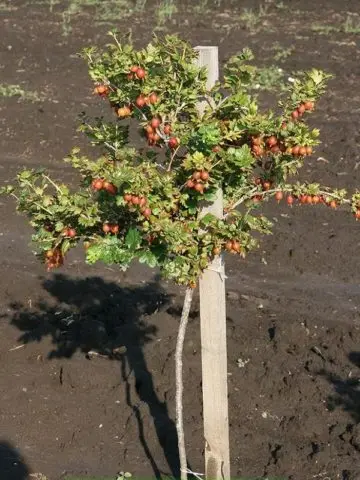
The height of a miniature tree ranges from 0,6 m to 1,5 m and depends on which method was used, what is the height of the grafting. The form is man-made, created only by the efforts of gardeners. The not quite natural appearance of the plant requires the installation of additional supports and protection from the winds.
Unusual form can be obtained in two ways:
- carrying out forming pruning;
- by grafting onto a rootstock.
Standard gooseberries, currants have one even trunk, at the top of which there are falling branches and leafy cover in the form of a cap.
Plants look very beautiful at any time of the year. In spring and summer, bright leaves, flowers and fruits are clearly visible on it, in autumn it turns into a bouquet of variegated leaves, in winter – a pattern of long winding branches is noticeable.
The benefits of growing gooseberries on a trunk
Gardeners who leave reviews of the standard gooseberry note a number of advantages of such a plant:
- due to the elevation of the crown above the ground, it is little susceptible to disease;
- the crown of the standard gooseberry is well ventilated even in a quiet place protected from winds and drafts;
- tree yield is a quarter higher than usual;
- berries remain intact, clean even after heavy rains and adverse weather;
- the branches of the standard gooseberry do not break in winter under the weight of snow;
- during frosts on the ground surface, fruit buds are not damaged, since they are located at a height of 40 cm from the ground;
- the life expectancy of a standard gooseberry is at least 15 years;
- under plants it is easy to cultivate the land;
- convenient to pick berries;
- the tree looks very decorative, serves as a decoration of the site.
Among the shortcomings of the standard gooseberry note:
- the high cost of seedlings;
- the need for constant removal of root shoots;
- the dependence of the strength and yield of the plant on only one shoot;
- to create a form, winter-hardy varieties are needed.
How can you make a standard gooseberry in your area
Due to the advantages of standard forms, they are becoming more and more popular. The prices for such seedlings are quite high, so gardeners are looking for ways to reconstruct shrubs with their own hands. One of the methods is as follows:
- Choose the most powerful, straight, vertically growing gooseberry shoot.
- Delete all branches except the selected one.
- At the left shoot, the lateral growth is cut off to the height of the trunk.
- They put a polyethylene tube on the future trunk that does not transmit light.
- The lower end of the pipe (10 cm) is buried in the ground.
- A peg is installed for support.
- Basal shoots are removed annually.
- Over the next years, a crown is formed, leaving no more than 5 branches.
You can get a tree not with the help of a rooted seedling, but by grafting on golden currants. Some gardeners who are good at this method graft several varieties, creating an elegant, interesting tree with different types of berries.
How to grow a standard gooseberry
Before proceeding with the formation of a standard gooseberry, it is worth remembering that this procedure will take quite a lot of time. After formation, a real crop can be harvested for about 6 years. By this time, a replacement for the “dying” gooseberry should be grown.
The standard plant should be supported in the form of a peg located on the side of the prevailing winds.
To obtain the correct shape of the gooseberry on the stem (photo), pruning is carried out, shortening powerful shoots that are inconveniently and ugly located.
Stamp forms require a more careful attitude. Despite winter hardiness, they should be placed in areas of the garden protected from northern winds. If the climate in the region is harsh, then for a successful wintering it will not be superfluous to create a reliable shelter.
What varieties are suitable for growing gooseberries on a trunk
Unlike ordinary bushes, the standard gooseberry cannot be covered with snow in winter. In the frost zone, the trees are above the snow cover. For this reason, it is worthwhile to carefully select varieties for specific regions of the country.
It is important that the plants are weakly branched, with a small amount of basal shoots. These varieties of gooseberries include:
Generous
This is a medium-sized spreading shrub with a large number of branches. Its foliage is small, the flowers are large, green-red. The fruits of an uneven red-violet color, rounded in shape, have a thin peel covered with hairs. The taste of berries is sweet and sour.
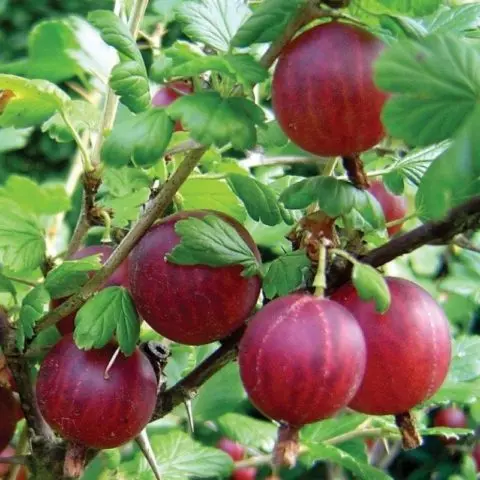
Redball
A new gooseberry variety without thorns. Its berries are large, red, hard, with green streaks on a red background. The taste of the fruit is pleasant, sweet and sour.
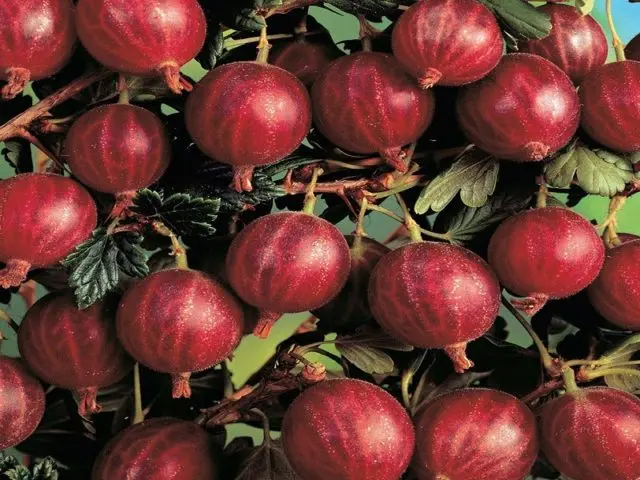
Harlequin
Medium spreading shrub. Its fruits are of medium size, oval, dark cherry, with a skin of medium thickness, without hairs. The taste of the berry is original, sour-sweet.
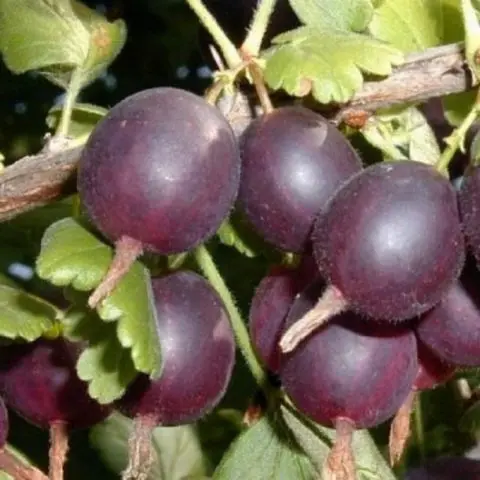
Invict
Represents a variety of English selection, the ripening period of which is medium. The berries are large, weighing 6 – 8 g. Bushes with thorns, vigorous. The standard gooseberry Invicta receives resistance to powdery mildew and other diseases from the bush.
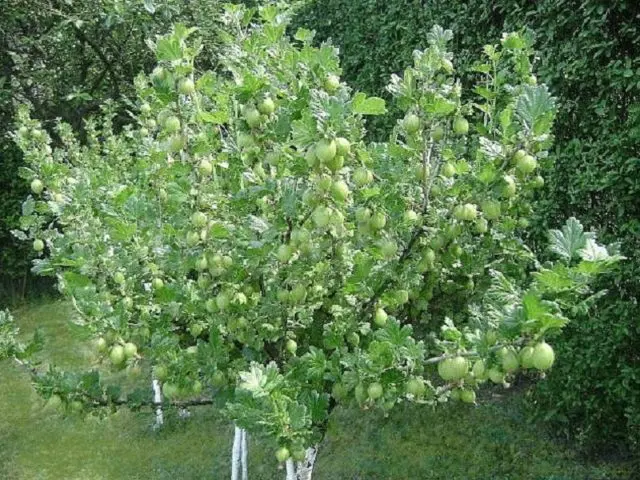
Spring
This is an early variety with excellent fruit taste. The height of the bush is 1,5 m. Its berries have a weight of 5 g, the shade is yellow.
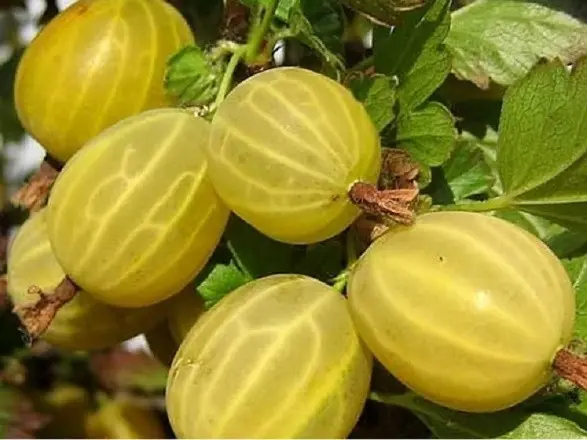
Red triumph
Fast growing variety with long and strong fruiting. Recommended for industrial cultivation.
Specialists and amateur gardeners who left their reviews of the gooseberry on the trunk Red Triumph noted its positive aspects:
- the tree looks very nice;
- he has a fast growth;
- excellent yield;
- ease of care.
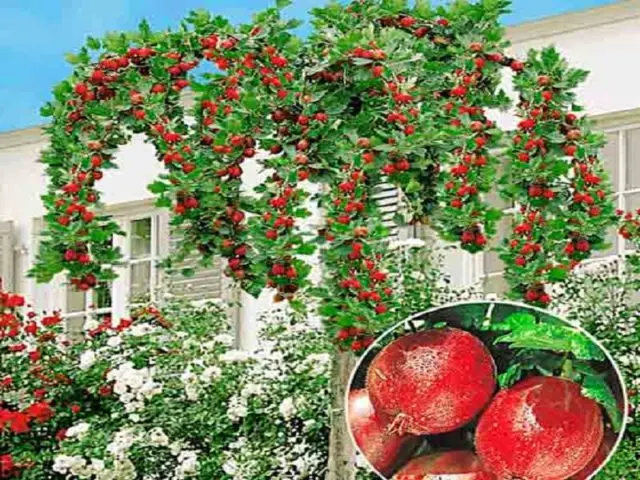
How to grow gooseberries on a stem
The easiest way to create a standard gooseberry is to form the plant into one trunk. This method is easy to use, available even to novice gardeners:
- When planting a bush in a permanent place after rooting, the strongest straight-growing shoot is left, removing the rest.
- The “blinding” procedure is carried out – all the kidneys are removed from the bottom of the shoot, leaving 4-5 pieces at the top.
- The shoots that have developed from the abandoned buds are shortened by half in the first year of the formation of the standard gooseberry.
- In subsequent years, aged, fruit-bearing, damaged or diseased branches are pruned.
- Basal shoots are periodically removed.
Growing standard gooseberries by grafting
To grow standard gooseberries using grafting, it is necessary to prepare consumables. For this purpose, cuttings (graft) are cut from a varietal plant, thorns are cut off from them. Storage is carried out in wet sand, sawdust or peat at a temperature of about 3 ⁰С.
As a stock, golden currant is most often used.
Vaccination is carried out on pre-planted plants in the spring, at the beginning of sap flow.
The most common vaccination methods are:
- in split – allow different diameters of scion and rootstock;
- improved copulation – the dimensions of the slices are the same;
- into the side cut – suitable for grafting different varieties;
- as an example – a well-known method that allows different sizes of scion and rootstock.
Planting and caring for standard gooseberries
Autumn is considered the most favorable time for planting a standard gooseberry. Spring – can lead to the death of a tree, because after the onset of heat the soil becomes dry, the roots do not have time to take root.
When placing a standard gooseberry in a permanent place, it is necessary to dig planting pits at a distance of at least 1 m from each other, with row spacing of 2 m.
The site should be protected from the north winds, well lit. The soil for the plant is fertile, light.
For a proper fit you need:
- Dig a hole 50 cm deep and 60 cm wide in advance.
- Fill it 3/4 with fertile soil, mix with fertilizers (200 g of superphosphate), ash.
- Spill the hole with 20 liters of water.
- Cut off the damaged parts of the roots and dip them in a clay mash.
- Place the seedling in the hole, straighten the roots, fill in the voids and compact the soil a little.
- Deepen the root neck by 5 cm.
- Water again.
- Mulch the trunk circle with peat.

Care instructions
Although the gooseberry is considered a drought-resistant crop, regular abundant watering, especially at the time of its flowering, will ensure a good harvest of berries. The roots of the standard gooseberry are at great depths, so the water must soak the soil at least 40 cm deep. The norm of a single watering under a tree is about 50 liters. The plant needs loosening of the soil and its further mulching, after which a crust does not form on the surface, weeds do not multiply, and moisture lingers in the soil. Sawdust can be used as mulch. straw, cut grass, peat.
In the year of planting, fertilizers are applied to the planting hole. The next top dressing is carried out in the second year of growth during the appearance of buds, then – during flowering and the last – during the period of berry setting. A mixture of nitrogen, potassium and phosphorus is used for this.
The standard gooseberry needs constant support in the form of a peg, installed from the side of the winds. It is cleaned of bark, treated with a special impregnation from decay, and painted. Important! The plant is tied in two places with a “figure eight” – in the middle of the trunk and at the level of the crown, so that constrictions do not form.
Periodic pruning is necessary to obtain a beautiful and functional crown of the standard gooseberry. During the first – they try to give it a rounded shape. After five years, a haircut is carried out in order to rejuvenate the plant, removing old and diseased branches.
It is very difficult to cover the standard gooseberry for the winter. Experts advise to carry out the simplest measures before the winter cold – increase the layer of mulch on the trunk circle, spud and cover the trunk with spruce branches.
Conclusion
The standard gooseberry is a new form of the well-known centenarian of gardens and orchards – the shrub gooseberry. It looks impressive, its ripening berries are much larger than usual ones. Subject to the rules of planting and proper care, a beautiful tree grows in the garden, bringing an enviable harvest.









